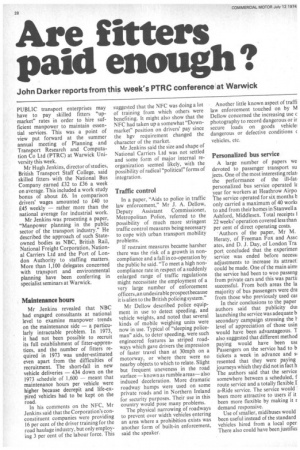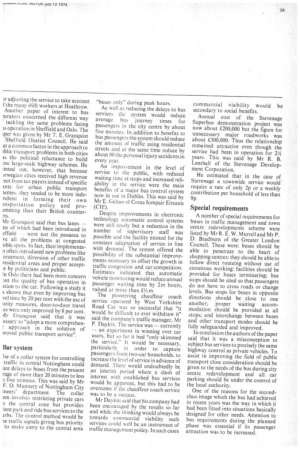Are fitters paid enough?
Page 30

Page 31

If you've noticed an error in this article please click here to report it so we can fix it.
John Darker reports from this week's PTRC conferencelat Warwick
PUBLIC transport enterprises may have to pay skilled fitters "upmarket" rates in order to hire sufficient manpower to maintain essential services. This was a point of view put forward at the summer annual meeting of Planning and Transport Research and Computation Co Ltd (PTRC) at Warwick University this week.
Mr Hugh Jenkins, director of studies, British Transport Staff College, said skilled fitters with the National Bus Company earned £32 to £36 a week on average. This included a work study bonus of about £6; In comparison drivers' wages amounted to £40 to £45 weekly — rather more than the national average for industrial work.
Mr Jenkins -was presenting a paper, "Manpower planning in the public sector of the transport industry." He described the approach of such Stateowned bodies as NBC, British Rail, National Freight Corporation, National Carriers Ltd and the Port of London Authority to staffing matters. More than 1,100 delegates concerned with transport and environmental planning have been conferring in specialist seminars at Warwick.
Maintenance hours
Mr Jenkins revealed that NBC had engaged consultants at national level to examine manpower trends on the maintenance side — a particularly intractable problem. In 1973, it had not been possible to recruit its full establishment of fitter-apprentices, and the number of fitters required in 1973 was under-estimated even apart from the difficulties of recruitment. The short-fall in new vehicle deliveries — 434 down on the 1973 schedule of 1,600 — meant that maintenance hours per vehicle were higher because decrepit and life-expired vehicles had to be kept on the road.
In his comments on the NFC, Mr Jenkins said that the Corporation's conconstituent companies were providing 16 per cent of the driver training for the road haulage industry, but only employing 3 per cent of the labour force. This suggested that the NFC was doing a lot of training from which others were benefiting. It might also show that the NFC had taken up a somewhat "Downmarket" position on drivers' pay since the hgv requirement changed the character of the market.
Mr Jenkins said the size and shape of National Carriers Ltd was not settled and some form of major internal reorganization seemed likely, with the possibility of radical "political" forms of integration.
Traffic control
In a paper, "Aids to police in traffic law enforcement," Mr J. A. Dellow, Deputy Assistant Commissioner, Metropolitan Police, referred to the possibility of much more stringent traffic control measures being necessary to cope with urban transport mobility problems.
If restraint measures became harsher there was the risk of a growth in noncompliance and a fall in co-operation by the public he said. "To meet a high noncompliance rate in respect of a suddenly enlarged range of traffic regulations might necessitate the employment of a very large number of enforcement officers,,an undesirable prospect beca use it is alien to the British policing system."
Mr Dellow described police equipment in use to detect speeding, and vehicle weights, and noted that several kinds of mobile weighing units were now in use. Typical of "sleeping policeman" aids, to deter speeding, were such engineered features as striped roadways which gave drivers the impression of faster travel than at 30mph on a motorway, or where there were no nearby objects to which to relate. Slight but frequent uneveness in the road surface — known as rumble areas— also induced deceleration. More dramatic roadway humps were used on some private roads and in Northern Ireland for security purposes. Their use in this country would pose many problems.
The physical narrowing of roadways to prevent over width vehicles entering an area where a prohibition exists was another form of built-in enforcement, said the speaker. Another little known aspect of traffi law enforcement touched on by M Dellow concerned the increasing use c photography to record dangerous or ir secure loads on goods vehicle! dangerous or defective conditions ( vehicles, etc.
Personalized bus service
A large number of papers we devoted to passenger transport su jects. One of the most interesting relati the performance of the personalized bus service operated h year for workers at Heathrow Airpo The service operated for six months only carried a maximum of 40 work( to and from their homes in Stanwell a Ashford, Middlesex. Total receipts 22 weeks' operation covered less than per cent of direct operating costs.
Authors of the paper, Mr M. Heraty, of Freeman Fox and Assc ates, and D. J. Day, of London Ira port concluded that the experimen service was ended before necess; adjustments to increase its attract. could be made. One of the main aimu the service had been to woo passeng from private cars and this was parth successful. From both areas the la majority of bus passengers were dra from those who previously used cal In their conclusions to the paper authors said that publicity dus launching the service was adequate b secondary campaign stressing the Ilevel of appreciation of those usin would have been advantageous. T also suggested that different method paying would have been use Passengers on the service had to b tickets a week in advance and si resented that they were paying journeys which they did not in fact h The authors said that the service somewhere between a scheduled, f route service and a totally flexible I a-Ride service. The service would been more attractive to users if it been more flexible by making it r demand responsive.
Use of smaller, midibuses would been useful instead of the standard vehicles hired from a local oper There also could have been justifiu )r adjusting the service to take account f the many shift workers at Heathrow. Another paper of interest to bus )erators concerned the different way tackling the same problems facing is operation in Sheffield and Oslo. The per was given by Mr T. E. Granquist Sheffield District Council. He said at a common factor in the approach to tblic transport problems in both cities ts the political reluctance to build D re large-scale highway schemes. He ,inted out, however, that because )rwegian cities received high revenue -ect from tax payers instead of specific tnts for urban public transport iemes. they tended to be more indendent in forming their own insportation policy and proimming than their British counterrts.
tr Granquist said that bus lanes — ne of which had been introduced in effield were not the panacea to ve all the problems at congested uble spots. In fact, their implementa often introduced new problems like orcement, diversion of other traffic residential areas and proper accept:e by politicians and public.
In Oslo there had been more concern )ut the quality of bus operation in Won to the car. Following a study it s shown that even by improving bus vel time by 20 per cent with the use of ority measures, door-to-door travel es were only improved by 8 per cent. dr Granquist said that it was essary to "adopt a more comprehen! approach in the solution of iroved public transport service".
liar system
Jse of a collar system for controlling traffic in central Nottingham could ace delays to buses from the present rage of more than 20 minutes to less a five minutes. This was said by Mr F. 0. Munnery of Nottingham City ineers' department. The collar em involves restricting private cars a the central zone but provides ient park and ride bus services to the trbs. The control method would be se traffic signals giving bus priority to make entry to the central area "buses only" during peak hours.
As well as reducing the delays to bus services the system would reduce average bus journey times for passengers in the city centre by about five minutes. In addition to benefits to bus passengers the system should reduce the amount of traffic using residential streets and at the same time reduce by about 80 the personal injury accidents in every year.
An improvement in the level of service to the public, with reduced waiting time at stops and increased reliability in the service were the main benefits of a major bus control system now in use in Dublin. This was said by Mr E. Gillian of Coras Iompair Eireann (CIE).
Despite improvements in electronic technology automatic control systems were still costly but a reduction in the number of supervisory staff was possible and the facility existed for the constant adaptation of service in line with demand. The system offered the possibility of the substantial improvements necessary to offset the growth in traffic congestion and car competition. Estimates indicated that automatic vehicle monitoring would reduce annual passenger waiting time by 2m hours, valued at more than £½m.
The pioneering chauffeur coach service operated by West Yorkshire Road Car was so successful that "it would be difficult to ever withdraw it" said the company's traffic manager, Mr P. Daykin. The service was — currently — an experiment in winning over car users, but so far it had "only skimmed the service." It would be necessary, particularly in order to capture passengers from two-car households, to increase the level of service in advance of demand. There would undoubtedly be an interim period where a clash of interest with established bus services would be apparent, but this had to be overcome if the chauffeur coach service was to be a success.
Mr Day kin said that his company had been encouraged by the results so far and while the thinking would always be towards commercial viability such services could well be an instrument of traffic management policy. In such cases commercial viability would be secondary to social benefits.
Annual cost of the Stevenage Superbus demonstration project was now about 000,000 but the figure for unnecessary major roadworks was about 000,000. Thus the relationship remained attractive even though the service had been in operation for 21A years. This was oaid by Mr R. B. Lenthall of the Stevenage Development Corporation.
He estimated that in the case of Stevenage a townwide service would' require a rate of only 2p or a weekly contribution per household of less than 9p.
Special requirements
A number of special requirements for buses in traffic management and town centre redevelopments scheme were listed by Mr R. E. W. Murrell and Mr P. D. Bradburn of the Greater London Council. These were: buses should be able to penetrate to the heart of shopping centres: they should be able to follow direct routeing without use of circuitous working: facilities should be provided for buses terminating; bus stops should be sited so that passengers do not have to cross roads or change levels. Bus stops for buses in opposite directions should beto one another; proper Waiting accommodation should be provided at all stops; and interchange between buses and other transport modes should be fully safeguarded and improved.
In conclusion the authors of the paper said that it was a misconception to subject bus services to precisely the same highway control as private vehicles. To assist in improving the field of public transport close consideration should be given to the needs of the bus during city centre redevelopment and all car parking should be under the control of the local authority.
One of the reasons for the secondclass image which the bus had achieved in recent years was the way in which it had been fitted into situations basically designed for other needs. Attention to bus requirements during the planned phase was essential if its passenger attraction was to be increased.




























































































